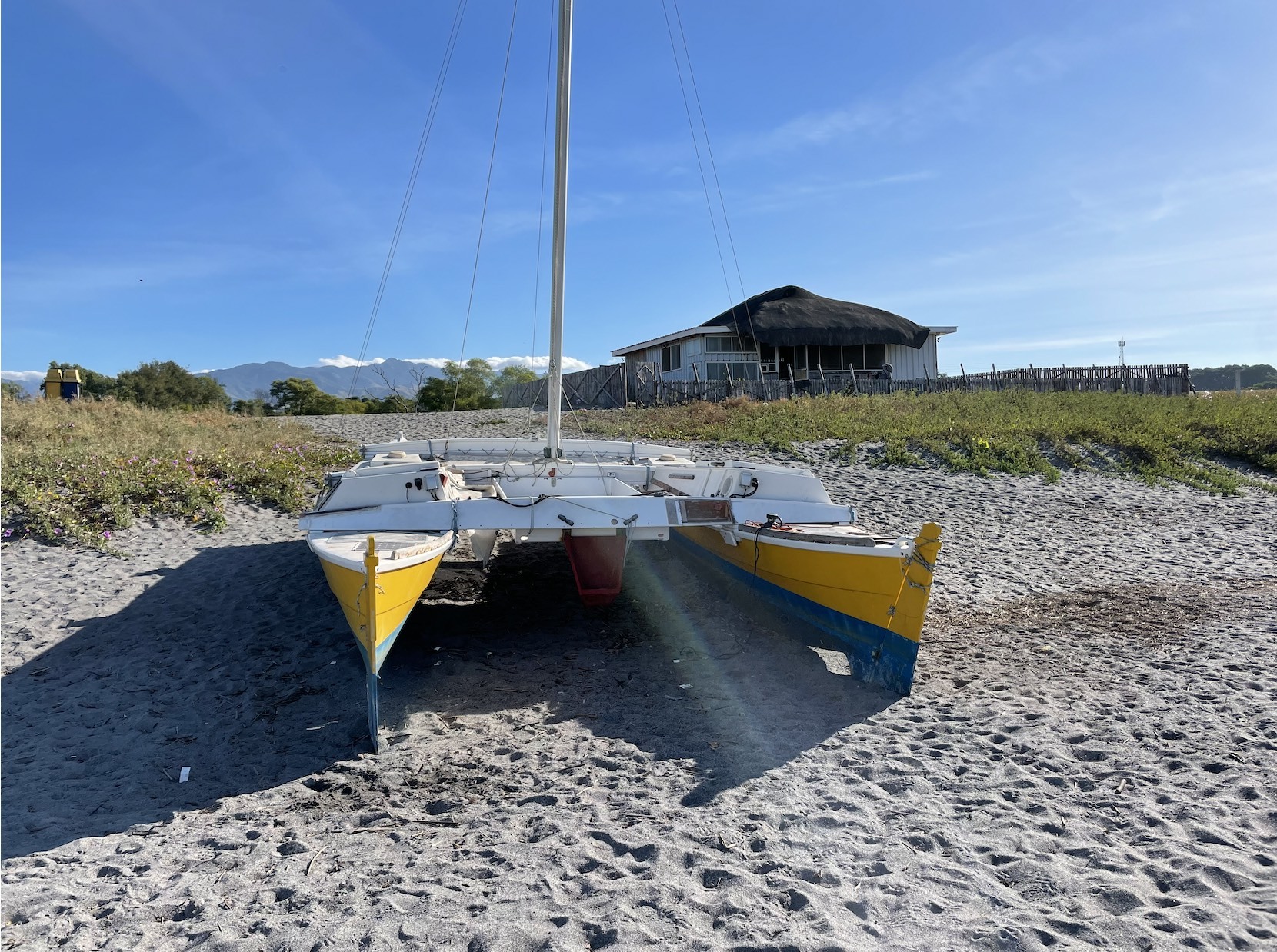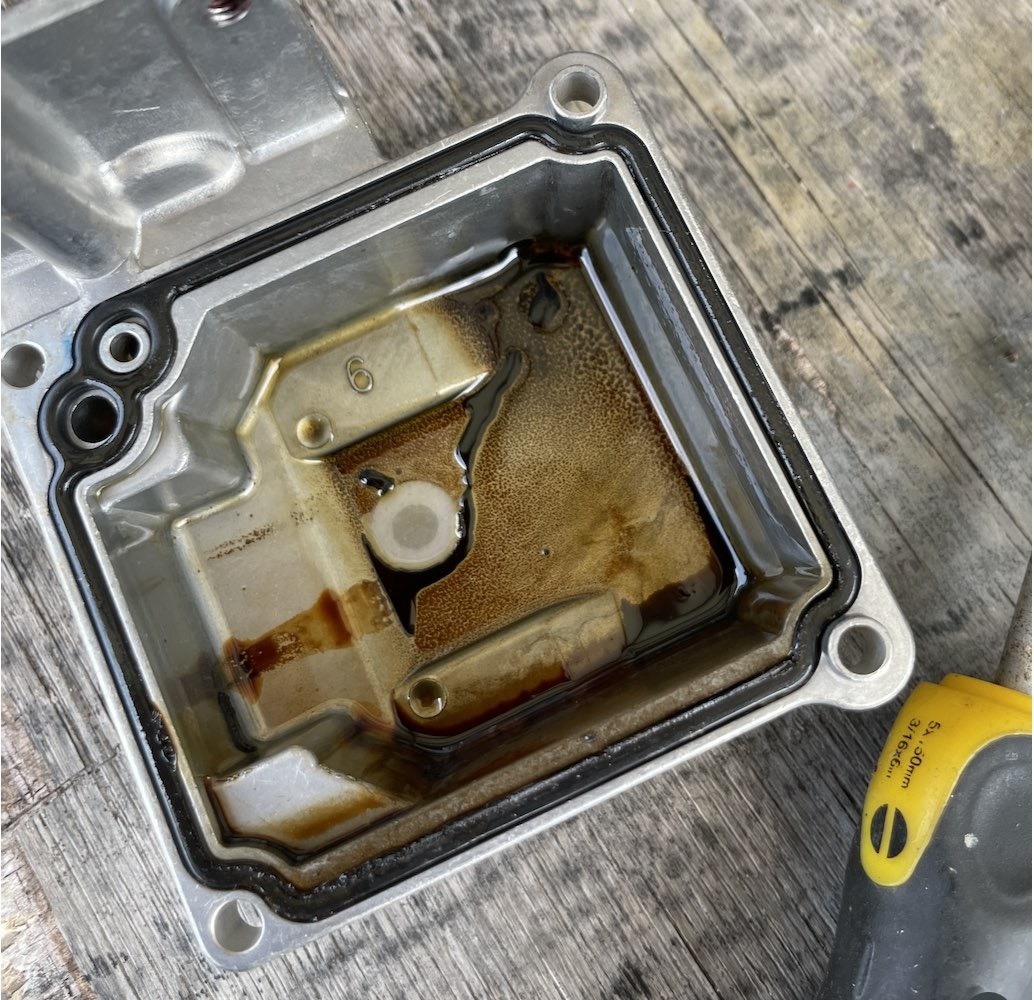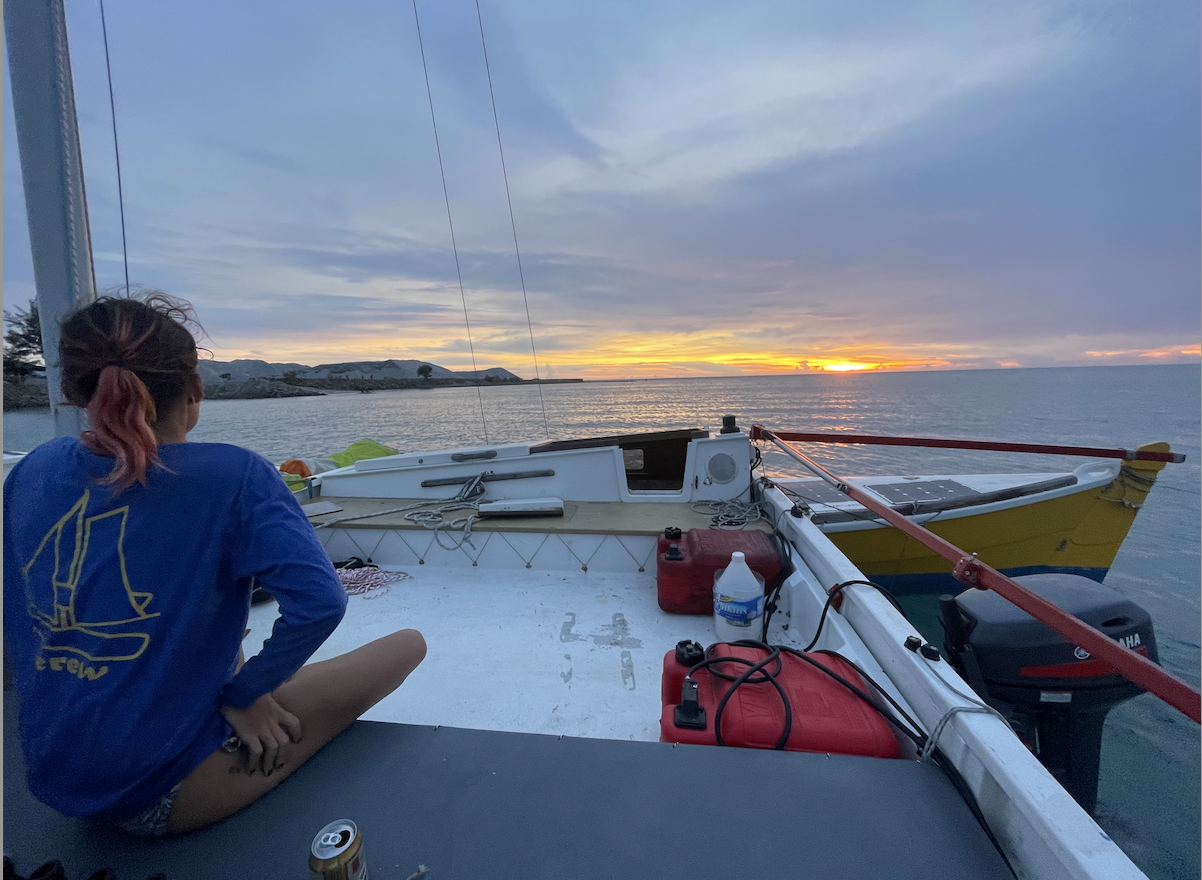Moving the boat from Iba Beach to Subic Bay
We finally got a place for Magayon II at the Watercraft Venture marina in the Subic Bay Freeport Zone (SBFZ), so some quick action was required to move the boat from Iba to Subic before the typhoon season starts. The plan included to use the electric outboard motor and the super heavy 15 hp Yamaha motor we had bought after sailing to Pandan Island and not being able to sail back because of the strong Amihan winds. Magayon had been on the beach in front of Miriam’s and Regis’ house since December 2023 because it had needed some repairs.

On Thursday night, June 27, 2024 Miriam and Martin drove from Subic to Sundowners Villas with the car full of stuff that we might need for the boat transfer. Regis had organised around 20 people to help launching the boat for the next day.
Preparing to launch
In the meantime the waves did reach the boat at high tide, although it was quite far up the beach. Waves had moved quite a bit of sand, so the boat looked a bit “dug in”, which provided a small challenge since the rudders are quite sensitive and should not be dragged backwards through the sand.

The canvass, which had been put over the boat to protect it from the local people climbing on it and removing components, had been taken down the day before. There was not much of a canvass left though, only lots of fragments, because the UV rays of the sunlight and weather had destroyed the plastic.
On Saturday morning, when working on getting the boat back in sailing condition, Martin found that the two halyards of the main sail, and some other components were missing / stolen. They had still been there the previous day so the thieves must have done it during the night. It is a pity, besides people climbing on the boat without asking permission to take a selfie, theft and vandalism was a major issue.
The jib halyard was not completely missing, the thieves had just cut it short. The remaining bit could be used by using two spare blocks and some thinner ropes we still had on stock to improvise two “emergency” halyards, one for the Wharram jib and the second for a Hobie main sail, that is a lot lighter than the Wharram main and also does not have a gaff and thus does not need two halyards. We doubted that these improvised solution would let us sail the 100 nautical miles from Iba to Subic Bay easily, so using the electric outboard motor with its limited range was not an option either. We had to fall back on the super heavy 15 hp Yamaha outboard motor, but that had not run since our trip to Pandan Island in December 2019 and needed to be tested first.
Testing and Repairing the Motor
An improvised motor test rig was set up quickly on Miriam’s work bench using some wooden beams, vices and a big plastic bucket, fuel was then bought, mixed with oil and the bucket filled with water for providing cooling water during the testing. Of course the motor did not start, it had not a single ignition. Taking out the spark plugs showed sparks, that the ignition was OK, and with some fuel inserted through the spark plug hole the motor would run for a few revolutions and then stop again. Disassembling the fuel filter and testing the lines with the manual fuel pump showed that they were not the root of the problem either. So the culprit had to be the carburetor.

Opening the drainage screw at the bottom of the float chamber did not release any fuel, only two small drops of sticky fluid came out. We therefore took the carb off the motor and opened the float chamber – it was totally dry, removed the float and the main nozzle and could identify the problem. The float valve was completely stuck and surrounded by tar like substance, must have been the remains of dried out two stroke oil. The main nozzle was open. After cleaning the valve, nozzle and the air and fuel channels with Q-tips, a pointed bamboo stick and soft copper wire (no pressurized air or ultrasound cleaner available) the carb was reassembled and mounted. The motor started at the fifth pull. However, it took two more times taking the carb apart to get the motor running properly:
- First the motor was reving too high: The float valve did not close properly and too much fuel was injected by the fuel pump. Liquid fuel came out of the main nozzle. A more thorough cleaning of the float valve was needed.
- After this was fixed, there was no idle. Cleaning of the idle nozzle and the main nozzle again helped.
Finally to motor ran properly, had good idle and we were ready to go.
Launching
The helpers came back after lunch with several ropes and two shovels. Nobody took pictures because the situation was quite stressful and we were all busy. The port of the boat was lifted up and long bamboo poles were placed on each side of each hull. Across those poles, that served as rails, shorter bamboo poles were placed under the keel of the hull. Two furrows were dug for the rudders not to hit the sand and then the boat was pushed bit by bit by the sheer force of 20 people towards the shore. Just before entering the sea Martin and Miriam went on board to handle the motor and rudders once in the water.
The waves were breaking quite violently. The motor had to be handled very carefully because it was far too heavy and powerful for the boat, it can cause structural damage to the aft cross beam. Martin got very worried when suddenly a piece covered with red paint came out below the outboard motor. The outboard bracket is painted red. After some scary minutes we managed to go far enough backwards into the breaking waves that we could shift forwards and turn the boat facing seawards. But we managed to slowly clear the area where the waves were breaking and dropped anchor to take Regis on board. Miriam jumped in the water to help him with bringing in the anchor, which we had dropped a few meters offshore, to have a line to pull the boat out, a pretty silly idea in retrospect.
The cruise to the new home
When everybody including anchor were on board we raised the other anchor and slowly made our way southwards, still with very high waves that put a lot of strain on the motor bracket and the aft cross beam. Since it was already late, we decided not to head for the coves but stay overnight in the Bucao river mound, next to the dredging ships that are in operation there. We anchored in front of a small beach that still had some local fishing boats. The place was quite protected from wind and the high waves. Martin did a visual inspection of the outboard bracket from the back of the hulls, nobody wanted to go swimming in this river water polluted by the dredgers.
The next morning we raised anchor at 6:00. To our excitement the sea was calm and the wind, while still blowing from the front, was not to strong either. We raised the jib, and after that worked well with the improvised halliard, also the Hobie Sail as “emergency” main. At this stage of the trip the sails did not provide for propulsion, but they did give good shade, highly appreciated since it was another one of these hot and sunny tropical days.
We did a short swimming break in a small cove at the entrance of Subic Bay for an urgently needed refreshment. That also allowed us to inspect the boat from the bottom more thoroughly. To our delight the red piece that was chipped off during the launch was only paint that had covered a stainless steel bracket of the motor mount. No structural damage was found.
After around 15 minutes swimming, some plastic trash started to arrive with the current and we raised anchor again and sailed into Subic Bay, with the wind now coming from aft. Despite having only the Hobie sail as main we managed to do 4-5 knots.
Mavic was monitoring us from the house, and then met us at the Watercraft marina. But first Skipper Miriam had to do an extra round in front of the Marina because a tourist boat with a wedding group on board was leaving while its captain always looked the other way. Then we got assigned a place at the pier at the shallowest part, at the very end where the Subic River enters the bay. Unfortunately the river is very polluted and the water is brown, but at least it does not stink. The boys of the marina helped us with securing the boat, and with unloading. Magayon II has a new home now. And Martin a new job, renovating and modifying her for Magayon II cruises out of Subic Bay.
We should aim at joining next years Easter or All Souls Regatta of the PGYC. That would be a great undertaking 3-4 days to sail to Puerto Galera, 3 days Regatta and 3-4 days sailing back. Are there any Volunteers for crew? See the announcement.
See also: Repair Log
